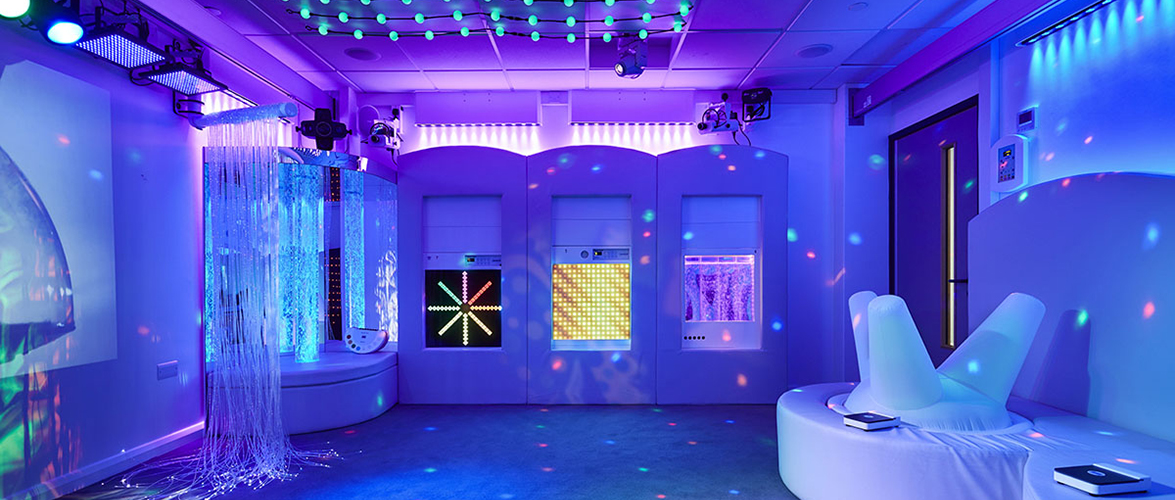
Multisensory rooms
History of Multisensory rooms
.
Do you ever wonder why watching a sunset over a lake or stream relaxes us? What is it about a hot, round, yellow ball slowly sinking in the horizon while clouds turn from white to pink and purple that makes us feel so at peace? How about when crickets chirp or frogs croak and harmonize with one another’s sounds? This combination of sounds, shapes, colors, and cooling temperatures is a recipe for serenity and relaxation. So where do you go to unwind if you’re trapped in an apartment in the city? Kosmorganic aesthetics often emulate natural environments and are sometimes called “immersive, sensory art installations” where visitors listen to repetitive hums and beats while they view abstract shapes that move like clouds, rain, mist, rivers, and wind.
Scientists from the company Snoezelen have developed rooms like these Kosmorganic artificial environments since the 1960s to provide peaceful and safe spaces for children with disabilities. They called these rooms multisensory. Psychologists discovered that things that echo the movement of seaweed underwater, bubbles in liquid, or plant growth, like petals of flowers or unwinding ferns, relax children with anxiety problems. Certain color combinations and smells with atmospheric or ambient music also calm the nerves. In fact, these therapeutic environments existed long before the mid-20th century. They go back thousands of years.
Bathing ceremonies with steam, music, incense, and sunlight emanating from geometric holes in the walls were ancient versions of multisensory rooms. The earliest example of a communal bath is the Great Bath, built over 4500 years ago in the Indus Valley (modern-day Pakistan).[1] Communal cleansing rituals were part of religious ceremonies, socializing, and even making business deals, as was the case in ancient Greece. In Japan, bathhouses were housed in Buddhist temples. The Native American Plains tribes organized sweat lodge ceremonies for spiritual and physical healing.[2] Groups of people would sit in a teepee around a pile of hot rocks while the master of the ceremony played drums, burnt sage, and chanted. These and similar traditions from other indigenous cultures are considered healing ceremonies and continue today in modernized forms all over the world. Recent studies reveal that these sweat lodge ceremonies prevent and treat infectious diseases, arthritis, skin disorders, substance addiction, and cancer and make people happier.[3]
The Ottoman Empire adopted the communal bathing ritual in the 14th century from the Romans. The Ottomans cleaned body and mind in these baths before praying. In ancient Persia, cleanliness and bathing were necessary for participating in Zoroastrian religious ceremonies. To clear their minds, people washed themselves of physical and spiritual contamination at communal bathhouses called hammams.[7] The hammam was not just a religious practice; people went to these bathhouses to meet friends or even find a mate. On special occasions, feasts and music were sometimes part of the hammam bathing ritual.[6] This practice continues today in ornate and beautiful bathhouses with intricate tile work and latticed walls. Since the depiction of living entities is forbidden in Islamic religious architecture, the vaulted walls are decorated with intricate patterns that mimic shapes found in nature. When light shines through the walls, the geometric holes cast beautiful shadows across the hammam. Sometimes they use cathedral-like stained glass windows. Hammam designers believe that light is the most essential aspect of hammam architecture because it represents God.[8] Geometric screens, lanterns, candles, and skylights cast colored shapes as if one is inside a kaleidoscope. [ Figure 1 ]One is not only receiving a water bath but also a light, color, and rhythm bath that is known as frequency bathing in Kosmorganic aesthetics. Read on for more information on frequency bathing.
[1] Edward Schafer, E., “The Development of Bathing Customs in Ancient and Medieval China and the History of the Floriate Clear Palace,” Journal of the American Oriental Society 76, no. 2 (1956): 57-82.
[2] Teresa Naseba Marsh, David C. Marsh, Julie Ozawagosh, and Frank Ozawagosh, “The sweat lodge ceremony: A healing intervention for intergenerational trauma and substance use,” International Indigenous Policy Journal 9, no. 2 (2018).
[3] Lawrence Berger, and Eric Rounds, Sweat Lodges: A Medical View. The IHS Provider 23, no 6 (June 1998): 69-75. https://www.ihs.gov/sites/provider/themes/responsive2017/display_objects/documents/1990_1999/PROV0698.pdf
[4] Simin Soleymani, “The Hammam : The Restoration and Revitalization of Teheran’s Qibla Hamman,” Thesis (M.Arch.) Carleton University, 2015.
[5] Müjgan Bahtiyar Karatosun, Tuba Nur Baz, “Turkish Baths as Cultural Heritage in the Context of Tangible and Intangible,” Architecture Research, 7, no. 3 (2017): 84-91.
[6] Soleymani, “The Hammam : The Restoration and Revitalization of Teheran’s Qibla Hamman.”
